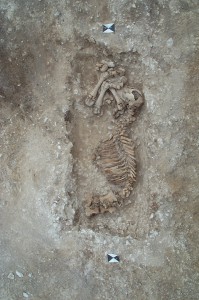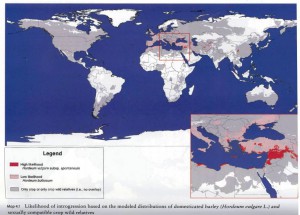IUCN has some nice new photos up at Flickr. I don’t really understand the eco-fashion ones, there are no crop wild relatives among the “Celebrating biodiversity” ones, 1 and, though there is a nod to agriculture in the set on adapting to climate change, the captions could be better. But that’s all just quibbling, and a bit of sour grapes, no doubt. I don’t see us in agricultural biodiversity doing any better.
Hold the phone! It’s a seriously endangered crop wild relative
It has happened, and January not even over yet. The IUCN’s Red List Species of the Day, which we are privileged to feature in a little widget over there on the right, has hit paydirt with a crop wild relative: Apium bermejoi, which Wikipedia says is “closely related to the wild form of celery”. What are the chances that it could confer resistance to some of the many pests and diseases that celery is martyr to? One expert told us: “my feeling is that it has not been used in celery breeding to any effect”. Anyone know differently?
A. bermejoi seeds are in storage, although in the wild there may be fewer than 100 individuals hanging in there on the island of Menorca.
Its habitat is often trampled by passing fishermen and hikers, or more seriously disrupted by off-road motorcyclists. In addition, Apium bermejoi must compete with a wide variety of other plant species for essential water and nutrients. Its present decline seems to be related to a series of drier summers, showing that this species is very sensitive to climate change.
That’s a lot to cope with.
Yasuní National Park disappoints lovers of crop wild relatives
The Yasuní National Park in Ecuador is apparently the mother of all biodiversity hotspots, “home to the most diverse array of plants and animals in South America and possibly the planet.” And not only that, it may actually continue to be so, unlike many other protected areas.
There are hints that the park could have extra conservation value in a warming world. Yadvinder Malhi, an ecologist at Oxford specializing in the Amazon, said that nearly all climate models simulating the impacts of global warming show the area staying wet even as other parts of the vast basin get drier.
Yeah, but has it got any crop wild relatives, I hear you ask. Well, I asked our friend Julian Ramirez at CIAT, who works with Andy Jarvis. Alas, only one species turns up in Yasuní from the genera of the main South America crops for which he has a decent number of geo-referenced observations (Arachis, Solanum, Phaseolus and Manihot): Manihot brachyloba. Andy, who did his PhD in Yasuní, says he also saw wild cacao and pineapples there. No doubt Julian is putting together the data for those genera as we speak.
Yasuní is of course in the Amazonian lowlands. Wild relatives of Phaseolus and Solanum are in other, nearby protected areas in the Ecuadorian Andes. But that’s another story. For this one: thanks, Julian.
Bringing back the aurochs
From our occasional contributor Michael Kubisch.
Anyone who has seen Jurassic Park (and who hasn’t) will understand how this film has stirred the imagination by suggesting the possibility of bringing back species that have long gone extinct. Add to that the recent breakthroughs in our ability to retrieve and decipher genomes obtained from tissues of animals that have perished thousands of years ago and you can understand the excitement. Italian scientists now claim to have a rough draft of the genome of the aurochs, a wild bovid that roamed Europe until perhaps as late as the 17th century and which is depicted so beautifully in the cave paintings in Lascaux. With the genome map as a compass the Italians are convinced that they can now breed back the aurochs using contemporary cattle breeds as a starting point.
Such attempts are, of course, not new and there are bovids around that are thought to resemble the aurochs. But in the past such efforts were always fraught with a fair degree of uncertainty because they relied entirely on phenotypic information gleaned from drawings or written descriptions. Having actual genetic information of the aurochs takes that uncertainty out of the equation. Whether the Italians’ efforts will be more successful is hard to predict because they are based on the assumption that all of the genetic information of the aurochs can still be found somewhere in modern cattle. And it is far from clear whether that is the case. But even if it isn’t, having the aurochs genome at hand, it may one day be possible to make the necessary genetic changes to transform a modern cattle embryo into an aurochs embryo and have that embryo then carried to term in a modern cow. And if you can bring back the aurochs, it may quite well be possible to bring back animal breeds that have similarly vanished. Still sounds a bit like science fiction? Perhaps, but nobody ever thought you could clone a sheep.

Book on gene flow published
I’ve just received a copy of “Gene Flow Between Crops and Their Wild Relatives” by Meike S. Andersson and M. Carmen de Vicente (Johns Hopkins). This will no doubt become the go-to reference book on the subject. There are chapters on all the major crops, with what look to me like very comprehensive bibliographies on each. Of particular interest are the maps of introgression risk at the end of the book. These will apparently be made available on the Bioversity website in due course. But here’s one (barley) in the meantime to whet your appetite.
